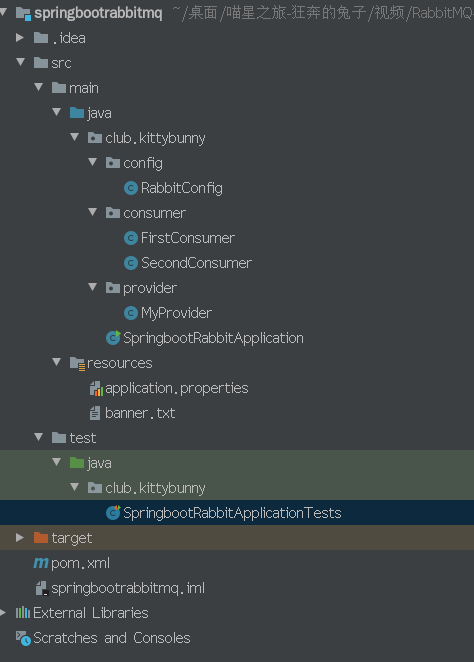1
2
3
4
5
6
7
8
9
10
11
12
13
14
15
16
17
18
19
20
21
22
23
24
25
26
27
28
29
30
31
32
33
34
35
36
37
38
39
40
41
42
43
44
45
46
47
48
49
50
51
52
53
54
55
56
57
58
59
60
61
62
63
64
65
66
67
| package club.kittybunny.config;
import org.springframework.amqp.core.*;
import org.springframework.beans.factory.annotation.Qualifier;
import org.springframework.context.annotation.Bean;
import org.springframework.context.annotation.Configuration;
import java.util.HashMap;
import java.util.Map;
/**
* @Author: bunny
* @Description: 我是兔子我会喵,我叫喵星兔
*/
@Configuration
public class RabbitConfig {
// 两个交换机
@Bean("topicEx")
public TopicExchange getTopicExchange(){
return new TopicExchange("BUNNY_TOPIC_EXCHANGE");//交换机名字
}
@Bean("fanoutEx")
public FanoutExchange getFanoutExchange(){
return new FanoutExchange("BUNNY_FANOUT_EXCHANGE");
}
// 两个队列,不同方式定义
//queue: QueueName, //队列名称
//durable: false, //队列是否持久化.false:队列在内存中,服务器挂掉后,队列就没了;true:服务器重启后,队列将会重新生成.注意:只是队列持久化,不代表队列中的消息持久化!!!!
//exclusive: false, //队列是否专属,专属的范围针对的是连接,也就是说,一个连接下面的多个信道是可见的.对于其他连接是不可见的.连接断开后,该队列会被删除.注意,不是信道断开,是连接断开.并且,就算设置成了持久化,也会删除.
//autoDelete: true, //如果所有消费者都断开连接了,是否自动删除.如果还没有消费者从该队列获取过消息或者监听该队列,那么该队列不会删除.只有在有消费者从该队列获取过消息后,该队列才有可能自动删除(当所有消费者都断开连接,不管消息是否获取完)
//arguments: null //队列的配置
//第5个参数: arguments 它的类型是一个键值对集合
@Bean("firstQueue")
public Queue getFirstQueue(){
Map<String, Object> args = new HashMap<String, Object>();
args.put("x-message-ttl",6000);
Queue queue = new Queue("BUNNY_FIRST_QUEUE", false, false, true, args);
return queue;
}
@Bean("secondQueue")
public Queue getSecondQueue(){
return new Queue("BUNNY_SECOND_QUEUE");//队列名字
}
// 三个绑定
@Bean
public Binding bindOne(@Qualifier("firstQueue") Queue queue, @Qualifier("topicEx") TopicExchange exchange){//使用bean的名字
return BindingBuilder.bind(queue).to(exchange).with("#.bunny.#");
}
@Bean
public Binding bindSecond(@Qualifier("secondQueue") Queue queue, @Qualifier("topicEx") TopicExchange exchange){
return BindingBuilder.bind(queue).to(exchange).with("changsha.#");
}
@Bean
public Binding bindThird(@Qualifier("secondQueue") Queue queue,@Qualifier("fanoutEx") FanoutExchange exchange){
return BindingBuilder.bind(queue).to(exchange);
}
}
|
